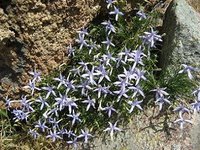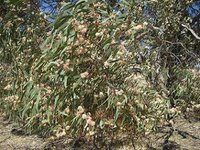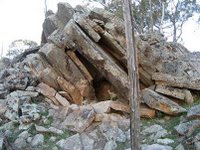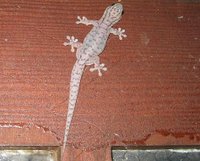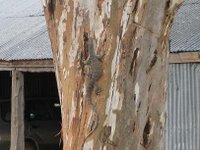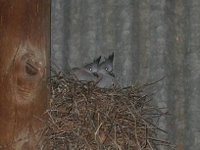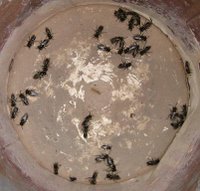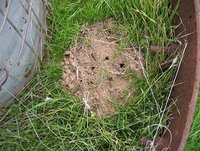Last night at a dinner party here in Melbourne the question was asked by one of our hosts whether anyone had any tips on how to grow green lawns without watering. Jan and I have never watered the lawn on any of our house blocks and in recent years I’ve made several changes from conventional lawn growing practices that have at least in part resulted in us having what I consider to be reasonable year-round green grass cover on our house block. Each of these changes, together with the underlying logic is below. It is the combination of factors rather than one item in particular that provide us with the end result we now have.
Not watering the lawnOur basic belief is that nature will make available the most appropriate vegetation type to match the soil, climatic & other conditions. Watering lawns favours the development of shallow rooted plants and creates a dependency on regular watering. Conversely not watering fosters the growth of deep rooted plants. The deeper the plant roots the greater the organic matter in the soil and the greater the ability the plants have to draw both water and minerals from depth.
It is also important to know that if treated well the type of plants growing will progressively improve to those that are generally accepted as being the best for the environment. In the early stages bare ground will be covered by mosses and in some cases lichens. In the first photo you will see ‘grass’ species growing. When we first came to our current home most of the area in the photo was bare ground and moss.
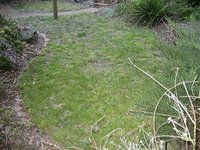 Cut the lawn at maximum mower height.
Cut the lawn at maximum mower height.Cutting the lawn at maximum height means that there is (or should) always a reasonable amount of green leaf left on the plants. This is turn means that each plant has at least some amount of ‘solar panels’ left to continue photosynthesis, recover reasonably quickly and maintain a green appearance. Interestingly, when cattle graze a healthy pasture for short durations at high densities they tend to leave the pasture height at a level similar to what a lawnmower does at full height. Mowing at maximum height also means that it is easier to push the mower through the grass and it can be done effectively using lower revolutions and fuel.
Cut the lawn when the plants are within growth Phase 2, which also by default means the frequency of cutting is reduced.Plants have 3 core growth phases:
Phase 1 – Essentially plants are ‘getting organised’ in terms of root mass and leaf volume for the major (next) growth phase. Most people tend to cut their lawns while the plants are still in Phase 1. This equates to over-grazing in a farming system. Plant root mass declines such that the plants die (in some cases) or at least never really prosper. Without ground cover and organic soil matter the loss of soil moisture is very rapid.
Phase 2 – This is the ‘power growth’ phase and lasts from the end of Phase 1 through to the time that the plant has just flowered and set seed but is still green. To grow healthy and dense pasture in a grazing enterprise the goal is to introduce stock when the plants are near the top or end of Phase 2. Mowing the lawn at this stage has the same impact of encouraging denser plant tillering and keeping the plants still in the green phase. NB. There is still likely to be ‘haying off’ or drying during the peak of summer but if the grass stand contains perennial plants there will still be a small amount of green leaf matter in the dry stand – meaning that recovery after rains is very rapid.
Phase 3 – This is pretty much the ‘haying off’ or drying period for the plant, during which gradual
senescence occurs.
Cutting the lawn within a couple of days of rainUntil such time as the lawn creates its own level of ground cover I only mow within a couple of days after it rains. In so doing I’m avoiding creating a mini-dust storm and also ensuring that as much top soil and organic matter remains on the soil surface as possible.
Not using the grass catcher i.e. leave the clippings on the lawnThe lawn clippings (where they are thrown by the mower) will normally not be noticeable within 2 days of mowing. So doing allows nature to recycle the nutrients, reducing or eliminating the need to apply external fertilizers, and supplies a natural mulch – increasing soil moisture retention and infiltration. It also makes the effort of mowing much less and avoids the need to (and expense of) placing the clipping somewhere else.
Not applying fertilizersThe application of inorganic fertilizers (which are by default ‘salts’ as they are water soluble) can increase the salt levels in the soil and in so doing kill off worms and other in-soil organisms. I guess I could apply organic fertilizers. However this would make the grass grow faster, meaning I’d have to mow more often, which I don’t want to do!
Worms play a very important role in soil health through creating ‘tunnels’ to enhance water infiltration and also improving soil quality. Did you know that all worms have the ability to detoxify carcinogenic substances in the soil (assuming they are able to actually survive in the toxic soil)?
Not trimming the edges (or out the back at least)The main reason I don’t do this is that I could not be bothered! However by not trimming the edge I am also encouraging ‘edge effect’ within the back-yard environment – creating a different environment or micro-climate for the protection and encouragement of creatures such as small lizards, which in turn help control the numbers of some ‘pest’ organisms such as flies and other insects.
Not using Glyphosate to kill plants in the lawnGlyphosate is the key ingredient in
Roundup, and is used by many people to kill unwanted grass around edges, in garden beds, and in cropping. It is known and accepted that glyphosate kills tadpoles (and by default up to 95 % of frogs in the environment) if it ends up in creeks and water supplies. Allowing the chemical to go into water is in direct contravention of the labeling instructions, but never-the-less I happen to believe frogs (especially tadpoles) have an important role in nature and do not want to take the chance of making an error.
Covering bare walking tracks with fallen leaves and bark from eucalypt treesMost people tend to lay pavers, which pretty much prevent water infiltration and encourages more rapid run-off, leading to flash flooding. Using bark and leaves reduces cost, improves infiltration, stops erosion, provides a place to spread the leaves and bark (rather than take the stuff to the tip), and provides a safer surface to be on in the wet as it is non-slip. Of course we also spread the leaves and bark on garden beds and other bare ground to provide cover and natural mulch.
 Minimising the use of pavers in other locations
Minimising the use of pavers in other locationsOur backyard, like many others, has a basketball ring and clothes line. It was tempting initially to pave the area under the clothes line and where the family plays basketball but we resisted; and only have pavers where one stands when actually hanging out the washing and practicing penalty basketball shots. Thus we are still allowing as much of the backyard as possible to directly receive and utilise natural rainwater. In the 3rd photograph you will see how healthy our lawn is, together with the location of some of the pavers ... and where the family plays basketball! Interestingly, if we don't play basketball for a couple of months the grass grows back over the bare ground progressively.
 Looking for & marveling at the gradual increase in plant diversity
Looking for & marveling at the gradual increase in plant diversityRather than ‘freak out’ when seeing, say, a milk or other thistle in the backyard we look at the plants and wonder what it is in the environment that led to nature’s decision to prompt such a plant to grow. Thistles are a broadleaf and have tap roots. Thus they are very effective at covering bare ground (reducing erosion and evaporation) and opening up the soil structure. They are also fairly low-down in the plant succession hierarchy. Thus as the health of the soil and ground cover increases their numbers decrease and will disappear. Broadleaf plants have great difficulty growing in dense healthy and high perennial pastures as they don't get the light they need to start, and find it difficult to spread their leaves.
Trialing ideasMost people have grown up in a paradigm telling them that a good lawn is a single plant species (monoculture) of, say, Couch or Kikuyu or Buffalo that is kept even through regular cutting. I challenge readers who have such a mindset to have the courage to run a small experiment in their backyard by setting aside an area of, say, 4 square metres (2 metres X 2 metres), not mowing it for 3-6 months, and closely watching to see what grows. Don’t freak out and run for the chemicals if you see Clover occurring … this is nature creating its own source of nitrogen for the benefit of other plants. If after then you mow that area when the plants are in Phase 2 you should be able to create an acceptable looking lawn that you can use like you have in the past.

